Viktor Reinhardt, Duane ZweifeL and Dick Pape
Wisconsin Regional Primate Research Center,
University of Wisconsin, 1223 Capital Court,
Madison, W1 53715, USA.
SUMMARY
Commercial macaque cages often have the following deficiencies:
- Animals living in lower-row cages receive considerably less light than those living in upper-row cages. This introduces a dependent variable which may bias scientific research data.
- The vertical dimension of the cage lacks structures and hence is inaccessible to the animal(s).
- Socially housed animals are provided no option(s) of temporary visual seclusion from cage mates. This may trigger antagonism associated with food competition.
Simple changes in cage design are described that ameliorate these deficiencies and create a healthier, more species-adequate micro environment for laboratory macaques.
INTRODUCTION
Cages for laboratory macaques are usually designed by technical professions little or no knowledge of, nor experience with the animals. The products are rather sterile structures that take sanitary requirements rather than the species-typical needs of the animal occupant into consideration. The design of the cage, however, may have an impact on the individual animal's general well-being and hence on the validity of research data collected from it.
The present report describes simple technical improvements of three common deficiencies of commercial macaque cages.
Dark lower-row cages
Laboratory macaques are usually housed in rows of stacked cages, with animals in lower rows intrinsically receiving less light than those living in upper rows1. From the scientific standpoint, physiological data collected from lower-row caged subjects may not be compared without reservation with data collected from upper-row caged subjects because of the effects light exerts on bodily functions, particularly on the neuro-endocrine system2-5. U.S. federal rules regarding "specifications for the humane handling, care, treatment, and transportation of nonhuman primates" stipulate that "lighting must be uniformly diffused throughout animal facilities and provide sufficient illumination to aid in maintaining good housekeeping practices, adequate cleaning, adequate inspection of animals, and for the well-being of the animals6". Lighting conditions for lower-row caged subjects frequently do not meet this criteria. A simple change in cage design ameliorates this inadequacy.
The solid side panels of lower-row cages are replaced by mesh walls (Figure la). Mesh walls separating different animals in adjacent cages are dense enough to make it impossible for the animals to stick their fingers through them. Unlike the solid side panels, mesh walls are permeable to the light that is reflected from the walls of the room.
Replacing the light-impermeable panels of lower-row cages with light-permeable mesh substantially increases the intensity of light (Figures 1a and 1b). This not only creates a healthier environment for the caged subject(s) thereby improving scientific methodology, but it also permits better visual health checks and more efficient cleaning of (previously dark) cage comers by animal care personnel.
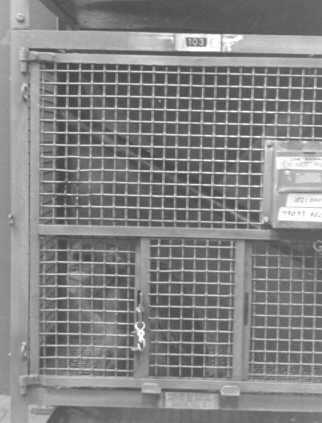
FIGURE 1a. Lower-row cage with left side panel replaced by a mesh wall; light intensity in center of cage: 53 lux.

FIGURE 1b. Same cage as in Figure 1a before side panel was replaced by a mesh wall; light intensity in center of cage: 22 lux.
Inaccessibility of vertical space
Access to the vertical space of their living area is probably essential for the well-being of captive macaques as they show a marked preference to remain off the floor on elevated sites 7-9. Commercial macaque cages, however, usually provide the animals horizontal but no accessible vertical space. Apart from clinging to the mesh ceiling during fear-inducing situations, the animals have little opportunity to make use of the upper portion of the cage. A properly installed perch can overcome this deficiency.
In standard cages, perches are suspended diagonally with a slope of approximately 15°. The lower end of the perch is attached with a chain at the front frame of the cage (Figure 2), the upper end rests loosely at the junction of the back and side wall of the cage (Figure 2). This mode of installation increases the usable cage space by opening up the vertical dimension.
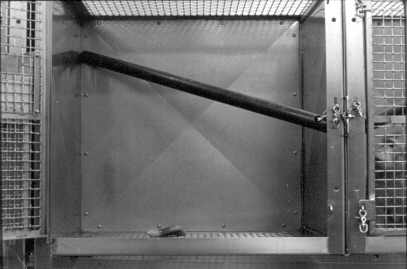
In restraint cages, perches are mounted in such a way that the squeeze-back can be moved freely. To achieve this, a stainless steel sleeve is mounted over a hole cut into the squeeze-back and a socket mounted exactly in line with it inside the front of the cage (Figure 3).
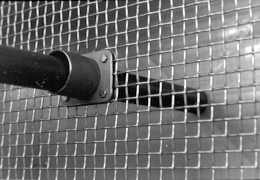
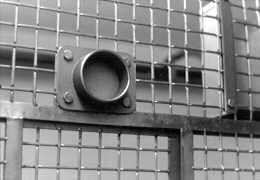
Perches are installed high enough to permit free movement of the animal(s) under it (Figure 2).
Single caged adult rhesus macaques spent approximately 1/4 of their time sitting in an elevated position on the perch1. The perch is especially useful to the animals when their cage is cleaned, offering a dry place to comfortably sit while the floor is sprayed with water10.
Lack of privacy from cage mates
Commercial cage modules for groups of macaques usually provide no visual barriers for temporary seclusion. A passage hole in the cage-dividing panel(s) can correct this circumstance.
A rectangular opening with smooth edges is cut close to the back - not the front - of the cage to break visual contacts between cage mates during potentially competition-inducing situations of feeding from the food boxes mounted at the front of the cage (Figure 4). In squeeze-back compartments, the position of the passage hole is determined by the pull rods of the restraint apparatus (Figure 4).
A privacy panel not only is beneficial for the relationship between cage companions10, but it also offers the animals a dry retreat while the adjacent section of the cage is cleaned with pressurized water.
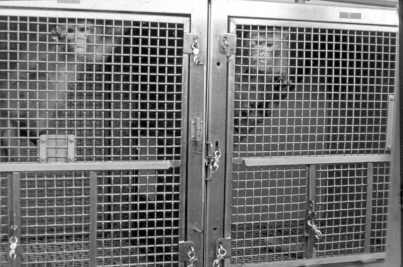
Acknowledgements
We are very thankful to Mrs. Annie Reinhardt for providing constructive comments on this manuscript and to Mrs. Jackie KiDney for proof reading it. This project was supported by NIH grant RR-00167 to the Wisconsin Regional Primate Research Center. Publication number 32-030 of the WRPRC.
References
1. Reinhardt, V. (1989). Evaluation of the long-term effectiveness of two environmental enrichment objects for singly caged rhesus macaques. Lab. Animal, 18 (6),31-33.
2. Dewan, E. M. ( 1967). On the possibility of a perfect rhythm method of birth control by pe light stimulation. American Journal of Obstetrics and Gynaecolgy, 99, 1016-1019.
3. Dewan, E. M., Menkin, M. F., Rock, J. (1978). Effect of photic stimulation on the human menstrual cycle. Photochemistry and Photobiology, 27, 581-585.
4. Bowers, C. L., Elton, R. H. (1982). Synchronization of menstrual cycles in pigtailed macaques using photoperiod. Journal of Medical Primatolgy, 11,252-256.
5. Wurtman, R. J., Axelrod, J., Kelly, D. E. (1968). The Pineal. Academic Press, New York.
6. U.S. Department or Agriculture (1991). Animal Welfare; Standards; Final Rule. Federal Register, 56, 6495-6505.
7. Bernstein, I., Mason, W. (1963). Activity patterns of rhesus monkeys in a social Group. Animal Behaviour, 11, 455-460.
8. Rosenblum, L., Kaufman, I., Stynes, A. (1964). Individual distances in two species of macaques. Animal Behaviour, 12, 338-342.
9. Reinhardt, V. (1992). Space utilization by captive rhesus macaques. Animal Technology, 43, 11-17.
10. Reinhardt, V., Smith, M. D. (1988). PVC pipes effectively enrich the environment of caged rhesus monkeys. Laboratory Primate Newsletter, 27(3), 4-5.
11. Reinhardt, V ., Reinhardt, A. ( 1991 ). Impact of a privacy panel on the behaviour of caged female rhesus monkeys living in pairs. Journal of Experimental Animal Science, 34, 55-58.
Reproduced with permission of the Institute of Animal Technology.